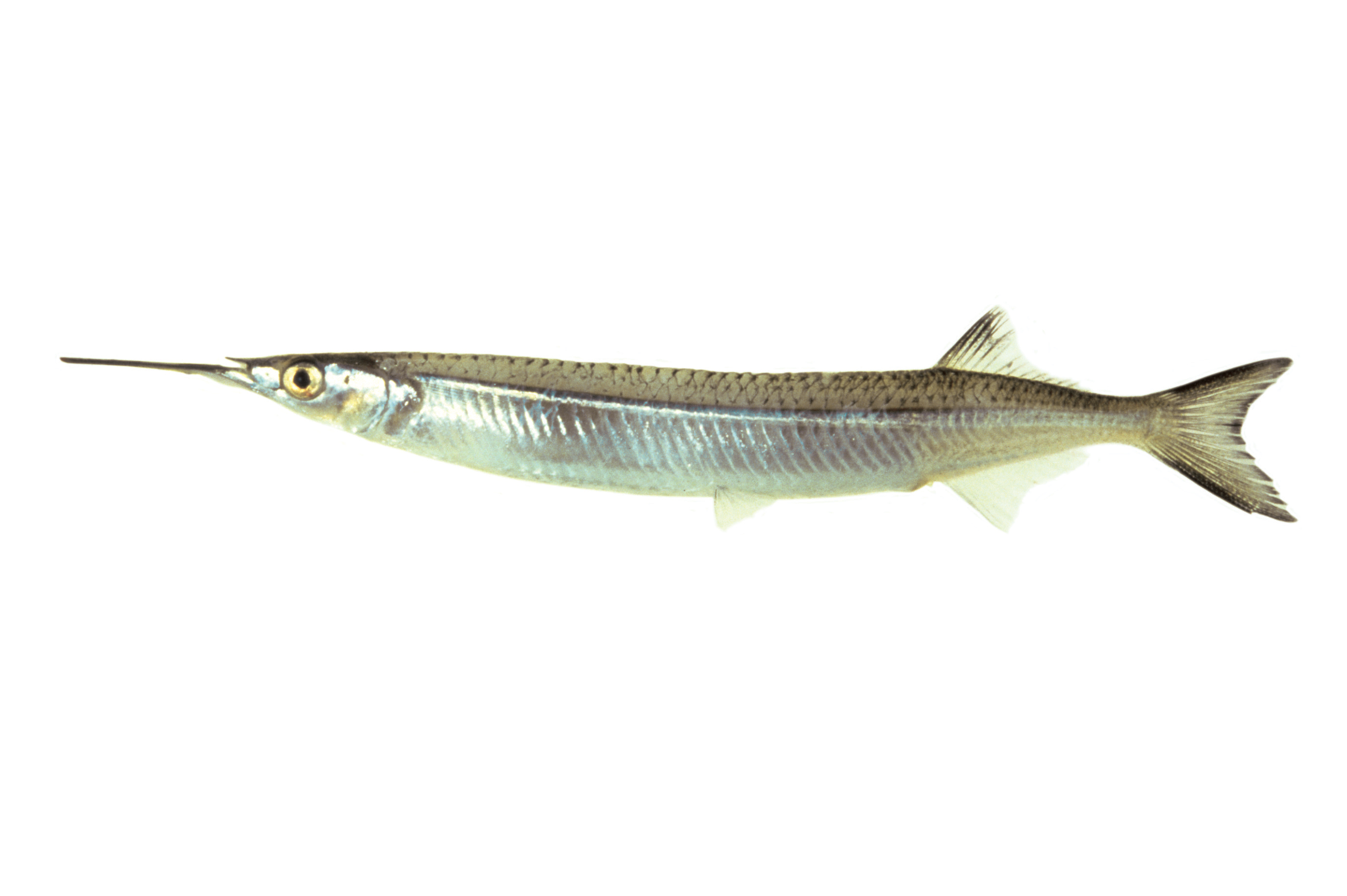River Garfish, Hyporhamphus regularis (Günther 1866)

River Garfish, Hyporhamphus regularis. Source: Rudie H. Kuiter / Aquatic Photographics. License: All rights reserved
River Garfish, Hyporhamphus regularis (Günther 1866)
More Info
|
Distribution |
Bunbury to Shark Bay, Western Australia (and possbily from the Onslow region), and north of Cardwell, Queensland, southwards to Franklin Harbour, South Australia (H. r. ardelio). Inhabits surface waters in bays, estuaries and sheltered coastal waters, often around seagrass beds. |
|
Features |
Dorsal fin 14-17; Anal fin 15-19; Pectoral fin 11-12; Caudal fin 15; Pelvic fin 6; Lateral line scales 58. Scales of moderate size, cycloid, weakly attached, covering body and most of head including at least some of triangular part of upper jaw; lateral line low on side, following ventral profile, lateral-line scales smaller than others on sides. Dorsal and anal fins small, of similar size and shape, located posteriorly on body opposite each other, anterior rays longest; caudal fin forked, lower lobe slightly larger than upper; pectoral fins of moderate size, arising high on side, reaching about one-fourth of way to dorsal-fin origin; ventral fins small arising slightly closer to anal-fin origin than to opercular edge, reaching far short of anal-fin origin; distance from ventral-fin origin to base of tail about equal to distance from ventral-fin origin to posterior edge of orbit. |
|
Size |
Reaches at least 35 cm, including beak. |
|
Colour |
Greenish above, silvery white below, with three narrow dark streaks running along foremost portion of back, and a longitudinal silver stripe from opercular edge to base of tail; tip of beak orange-red; fins yellowish with black spot at base of pectoral. |
|
Feeding |
Omnivorous feeding on zooplankton and seagrasses. |
|
Biology |
Spawning occurs between July and December. |
|
Remarks |
The river garfish has been split into two geographically separated sub-species, the eastern river garfish, Hyporhamphus regularis ardelio and the western river garfish, Hyporhamphus regularis regularis. The eastern form has a beak that is slightly longer proportionately than that of the western form. |
|
Species Citation |
Hemirhamphus regularis Günther 1866, Cat. Fish. British Museum 6: 261. Type locality: west Australia. |
|
Author |
Gomon, M.F. & Bray, D.J. 2018 |
|
Resources |
River Garfish, Hyporhamphus regularis (Günther 1866)
References
Coleman, N. 1980. Australian Sea Fishes South of 30ºS. Lane Cove, NSW : Doubleday Australia Pty Ltd 309 pp.
Collette, B.B. 1974. The garfishes (Hemiramphidae) of Australia and New Zealand. Records of the Australian Museum 29(2): 11-105 figs 1-23 (as Hyporhamphus regularis ardelio)
Gomon, M.F. 1994. Families Exocoetidae, Hemiramphidae, Scomberesocidae. pp. 383-393 figs 343-351 in Gomon, M.F., Glover, C.J.M. & Kuiter, R.H. (eds). The Fishes of Australia's South Coast. Adelaide : State Printer 992 pp. 810 figs.
Gomon, M.F. 2008. Family Hemiramphidae in Gomon, M.F., Bray, D.J. & Kuiter, R.H. (eds). Fishes of Australia's Southern Coast. Sydney : Reed New Holland 928 pp.
Grant, E.M. 1975. Guide to Fishes. Brisbane : Queensland Government, Co-ordinator General’s Department 640 pp.
Grant, E.M. 2002. Guide to Fishes. Redcliffe : EM Grant Pty Ltd 880 pp.
Günther, A. 1866. Catalogue of the Fishes of the British Museum. Catalogue of the Physostomi, containing the families Salmonidae, Percopsidae, Galaxidae, Mormyridae, Gymnarchidae, Esocidae, Umbridae, Scombresocidae, Cyprinodontidae, in the collection of the British Museum. London : British Museum Vol. 6 368 pp.
Hutchins, J.B. & Swainston, R. 1986. Sea Fishes of Southern Australia. Complete field guide for anglers and divers. Perth : Swainston Publishing 180 pp.
Hutchins, J.B. & Thompson, M. 1983. The Marine and Estuarine Fishes of South-western Australia. Perth : Western Australian Museum 103 pp. 345 figs.
Kailola, P.J., Williams, M.J., Stewart, P.C., Reichelt, R.E., McNee, A. & Grieve, C. 1993. Australian Fisheries Resources. Canberra : Bureau of Resource Sciences and the Fisheries Research and Development Corporation 422 pp.
Kuiter, R.H. 1993. Coastal Fishes of South-eastern Australia. Bathurst : Crawford House Press 437 pp.
May, J.L. & Maxwell, J.G.H. 1986. Field Guide to Trawl Fish from Temperate Waters of Australia. Hobart : CSIRO Division of Marine Research 492 pp.
Noell, C.J. 2003. Larval development of the southern sea garfish (Hyporhamphus melanochir) and the river garfish (H. regularis) (Beloniformes: Hemiramphidae) from South Australian waters. Fishery Bulletin 101(2): 368-376. Ref available online, open access
Prokop, F. 2002. Australian Fish Guide.Croydon South, Victoria : Australian Fishing Network 256 pp.
Roughley, T.C. 1957. Fish and Fisheries of Australia. Sydney : Angus & Robertson 341 pp.
Valenciennes, A. in Cuvier, G.L. & Valenciennes, A. 1847. Histoire Naturelle des Poissons. Paris : Levrault Vol. 19 544 pp. pls 554-590.
Whitley, G.P. 1931. New names for Australian fishes. The Australian Zoologist 6(4): 310-334 1 fig. pls 25-27 (as Reporhamphus ardelio)
Whitley, G.P. 1943. Ichthyological notes and illustrations. Part 2. The Australian Zoologist 10(2): 167-187 figs 1-10 (misidentified as Euleptorhamphus longirostris)
Valenciennes, A. in Cuvier, G.L. & Valenciennes, A. 1847. Histoire Naturelle des Poissons. Paris : Levrault Vol. 19 544 pp. pls 554-590. (paralectotypes from Sydney misidentifed as Hemiramphus gaimardi)
Yearsley, G.K., Last, P.R. & Ward, R.D. (eds) 1999. Australian Seafood Handbook. Hobart : CSIRO Marine Research 460 pp.


